Stakeholder Engagement Report: Wastewater and Desalination in Sydney
VerifiedAdded on 2023/06/13
|13
|3254
|99
Report
AI Summary
This report assesses public acceptance of treated desalinated water and wastewater as potable water, focusing on the Australian population, particularly in Sydney. It examines community views on wastewater reuse and seawater desalination for consumption, finding higher acceptance of desalinated water. The report also proposes community engagement strategies to promote the acceptance of wastewater as a potable water source, addressing concerns about hygiene and odor. It highlights the importance of information sharing and education to improve public perception and facilitate broader acceptance of recycled water as a sustainable water resource. Desklib offers similar documents and study tools for students.
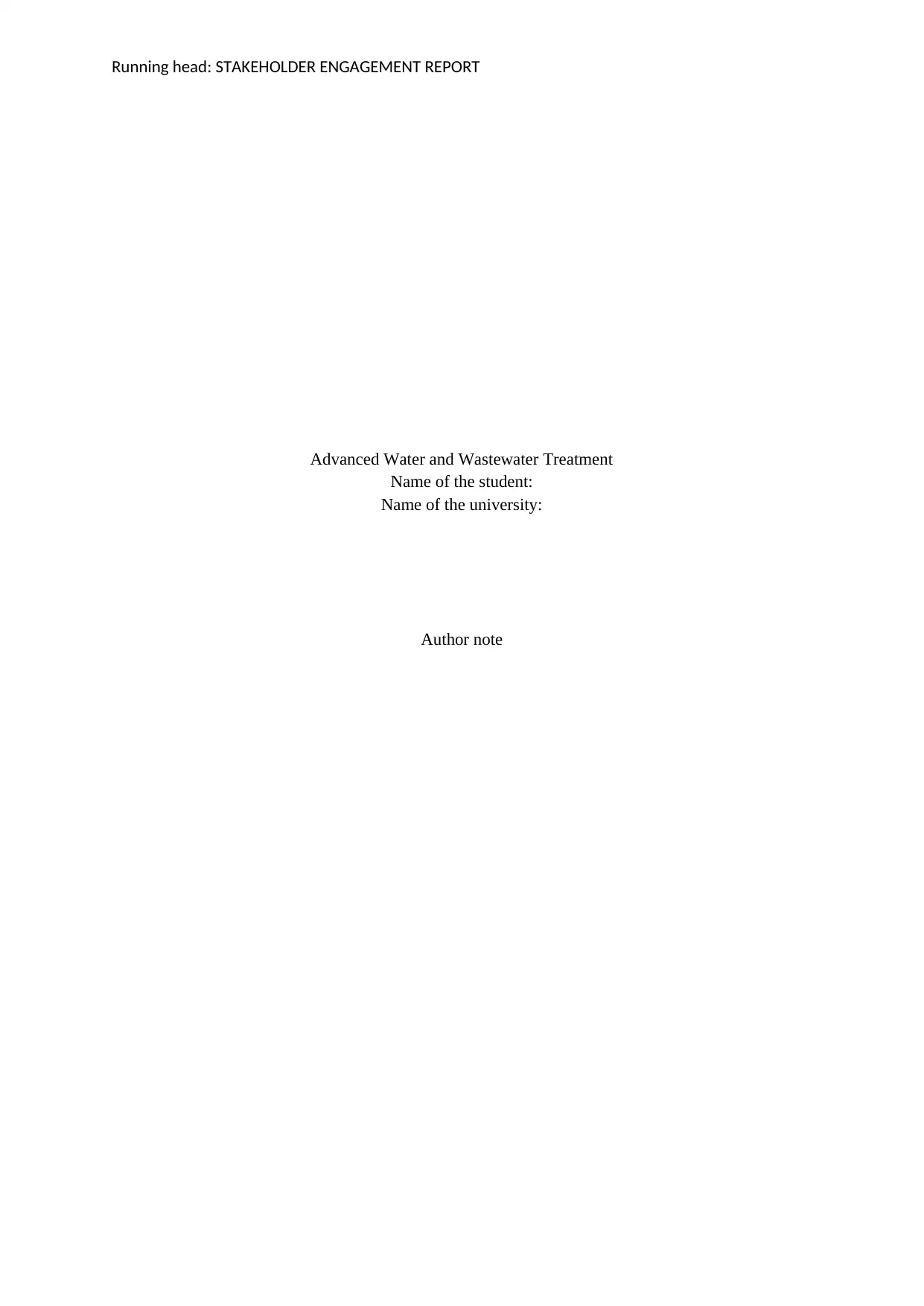
Running head: STAKEHOLDER ENGAGEMENT REPORT
Advanced Water and Wastewater Treatment
Name of the student:
Name of the university:
Author note
Advanced Water and Wastewater Treatment
Name of the student:
Name of the university:
Author note
Paraphrase This Document
Need a fresh take? Get an instant paraphrase of this document with our AI Paraphraser
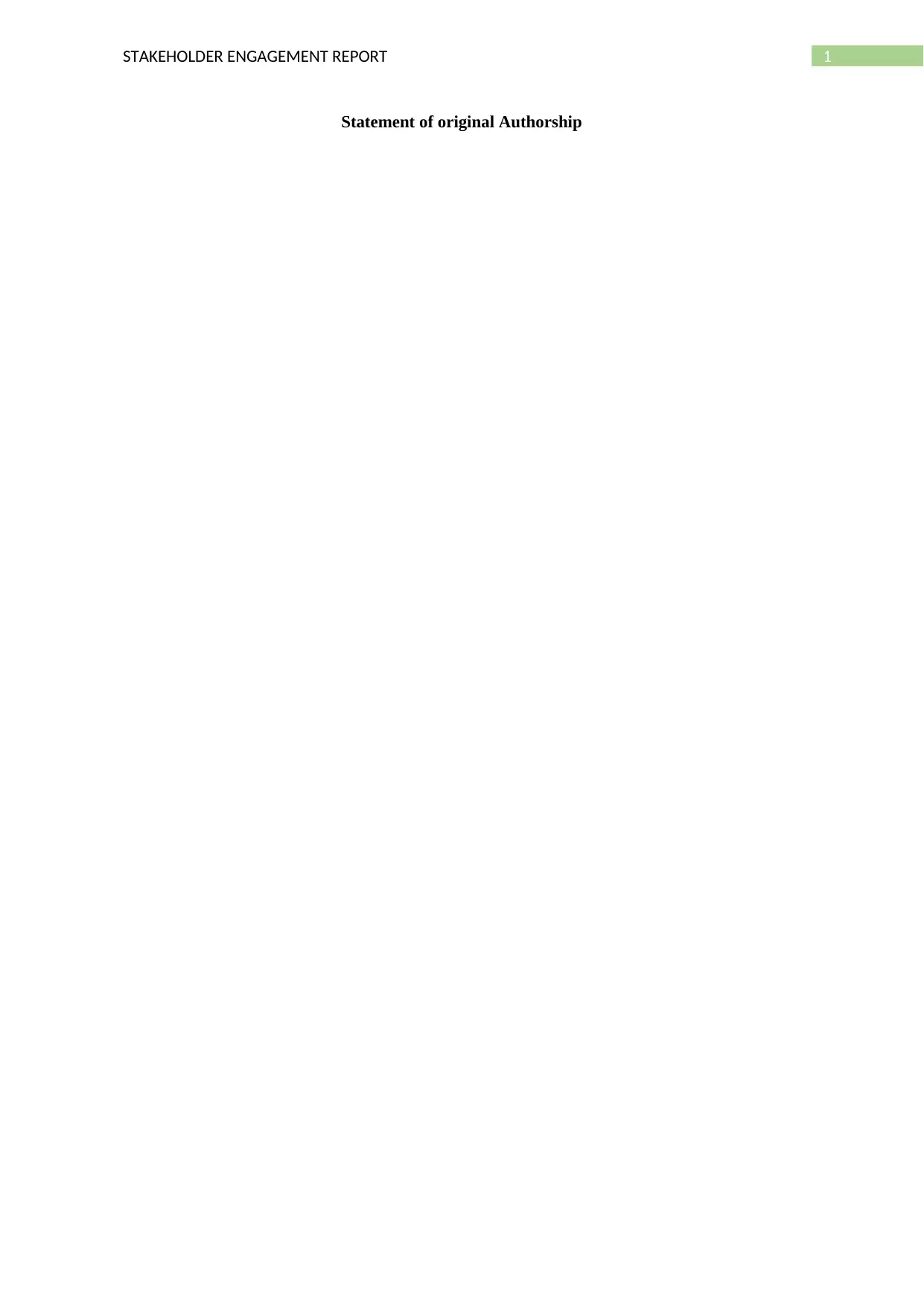
1STAKEHOLDER ENGAGEMENT REPORT
Statement of original Authorship
Statement of original Authorship
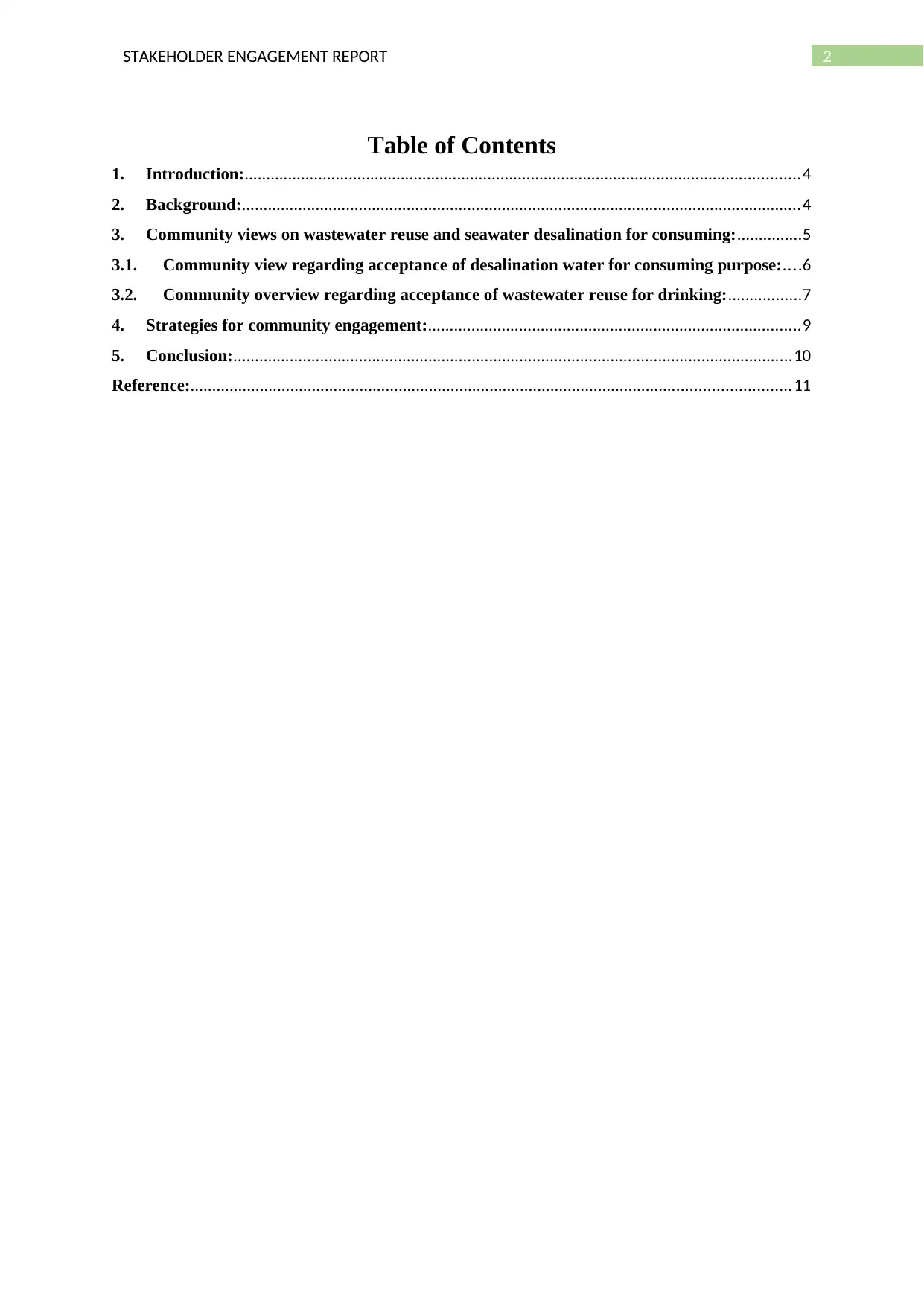
2STAKEHOLDER ENGAGEMENT REPORT
Table of Contents
1. Introduction:................................................................................................................................4
2. Background:.................................................................................................................................4
3. Community views on wastewater reuse and seawater desalination for consuming:...............5
3.1. Community view regarding acceptance of desalination water for consuming purpose:....6
3.2. Community overview regarding acceptance of wastewater reuse for drinking:.................7
4. Strategies for community engagement:......................................................................................9
5. Conclusion:.................................................................................................................................10
Reference:..........................................................................................................................................11
Table of Contents
1. Introduction:................................................................................................................................4
2. Background:.................................................................................................................................4
3. Community views on wastewater reuse and seawater desalination for consuming:...............5
3.1. Community view regarding acceptance of desalination water for consuming purpose:....6
3.2. Community overview regarding acceptance of wastewater reuse for drinking:.................7
4. Strategies for community engagement:......................................................................................9
5. Conclusion:.................................................................................................................................10
Reference:..........................................................................................................................................11
⊘ This is a preview!⊘
Do you want full access?
Subscribe today to unlock all pages.

Trusted by 1+ million students worldwide
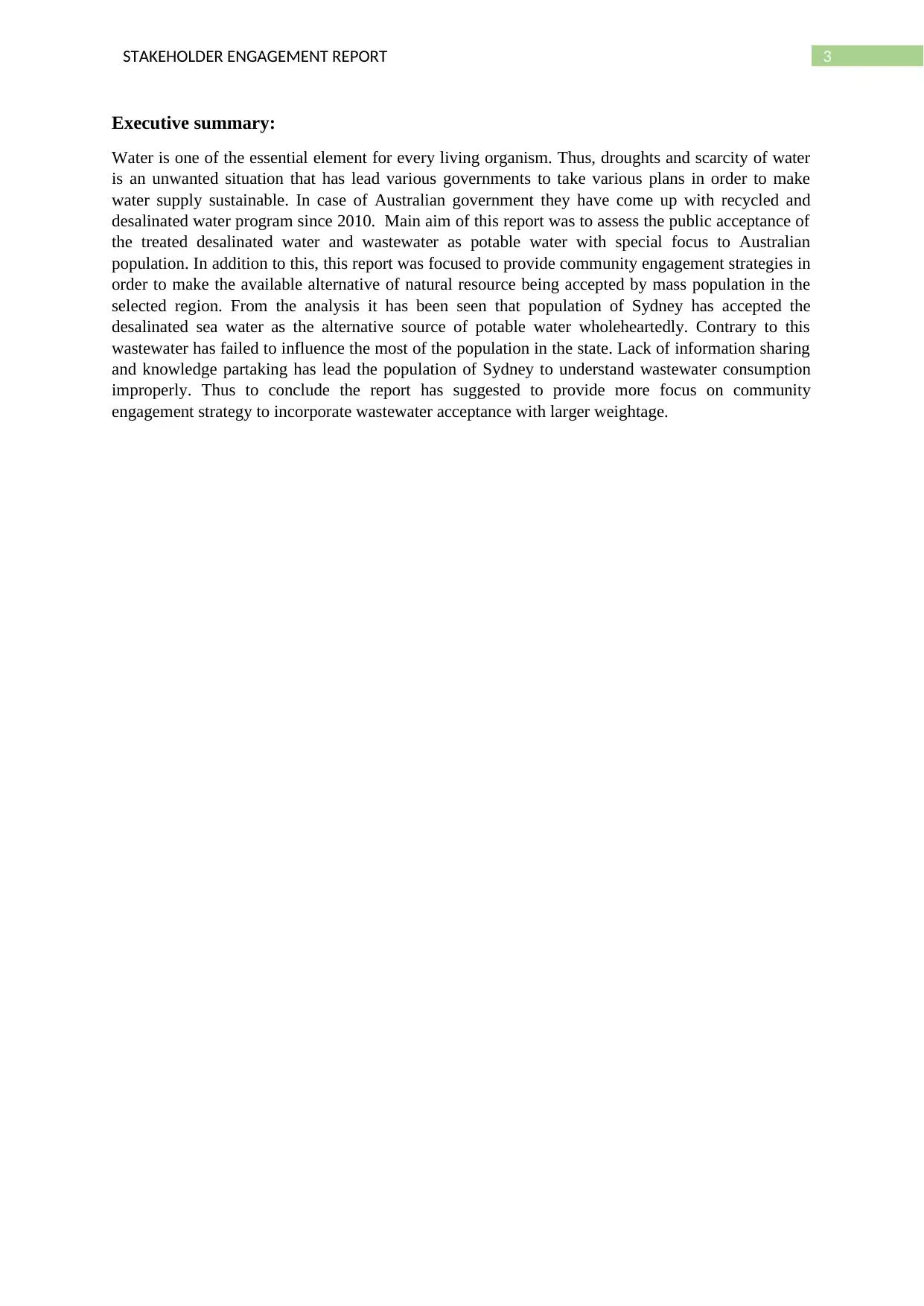
3STAKEHOLDER ENGAGEMENT REPORT
Executive summary:
Water is one of the essential element for every living organism. Thus, droughts and scarcity of water
is an unwanted situation that has lead various governments to take various plans in order to make
water supply sustainable. In case of Australian government they have come up with recycled and
desalinated water program since 2010. Main aim of this report was to assess the public acceptance of
the treated desalinated water and wastewater as potable water with special focus to Australian
population. In addition to this, this report was focused to provide community engagement strategies in
order to make the available alternative of natural resource being accepted by mass population in the
selected region. From the analysis it has been seen that population of Sydney has accepted the
desalinated sea water as the alternative source of potable water wholeheartedly. Contrary to this
wastewater has failed to influence the most of the population in the state. Lack of information sharing
and knowledge partaking has lead the population of Sydney to understand wastewater consumption
improperly. Thus to conclude the report has suggested to provide more focus on community
engagement strategy to incorporate wastewater acceptance with larger weightage.
Executive summary:
Water is one of the essential element for every living organism. Thus, droughts and scarcity of water
is an unwanted situation that has lead various governments to take various plans in order to make
water supply sustainable. In case of Australian government they have come up with recycled and
desalinated water program since 2010. Main aim of this report was to assess the public acceptance of
the treated desalinated water and wastewater as potable water with special focus to Australian
population. In addition to this, this report was focused to provide community engagement strategies in
order to make the available alternative of natural resource being accepted by mass population in the
selected region. From the analysis it has been seen that population of Sydney has accepted the
desalinated sea water as the alternative source of potable water wholeheartedly. Contrary to this
wastewater has failed to influence the most of the population in the state. Lack of information sharing
and knowledge partaking has lead the population of Sydney to understand wastewater consumption
improperly. Thus to conclude the report has suggested to provide more focus on community
engagement strategy to incorporate wastewater acceptance with larger weightage.
Paraphrase This Document
Need a fresh take? Get an instant paraphrase of this document with our AI Paraphraser
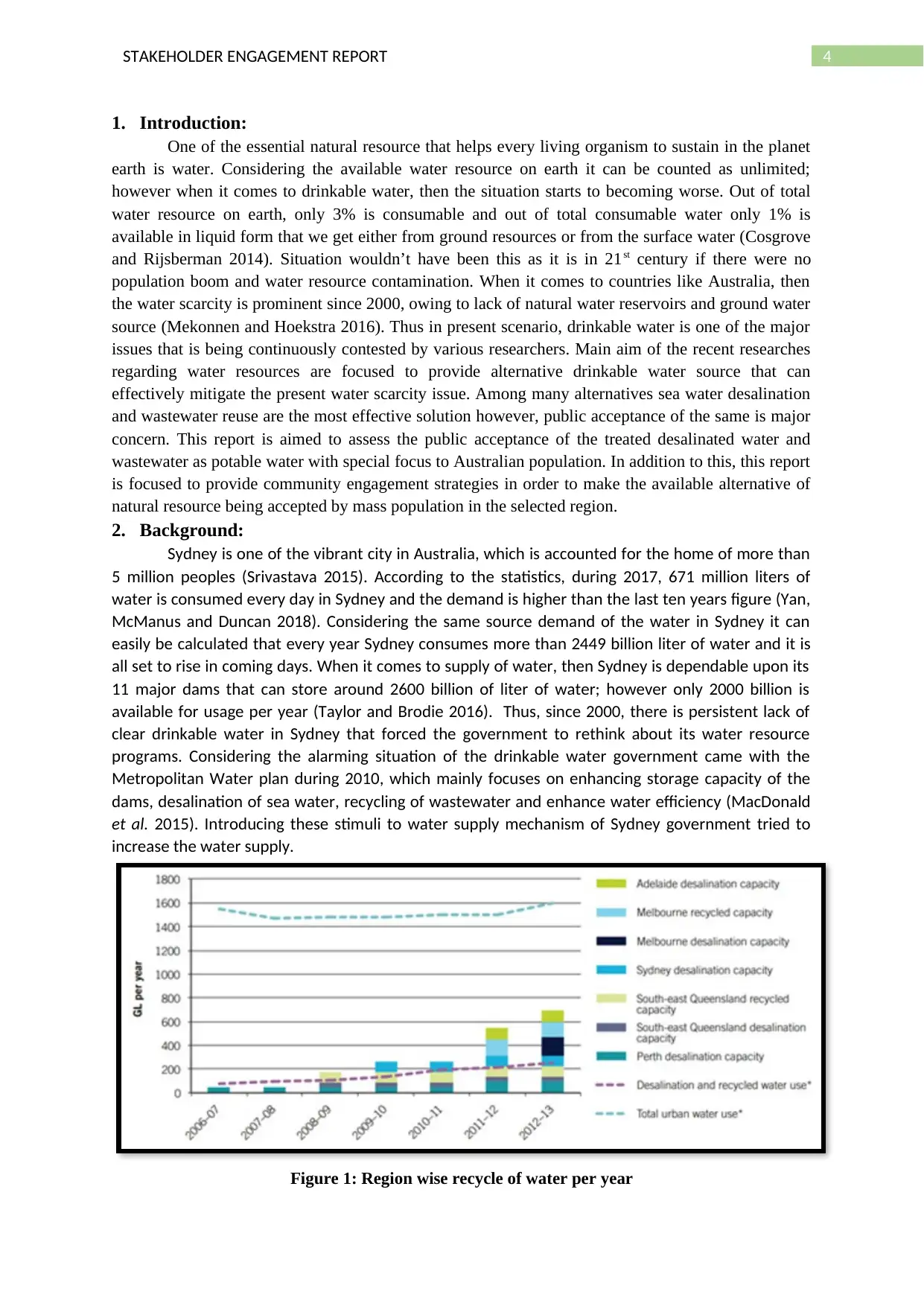
4STAKEHOLDER ENGAGEMENT REPORT
1. Introduction:
One of the essential natural resource that helps every living organism to sustain in the planet
earth is water. Considering the available water resource on earth it can be counted as unlimited;
however when it comes to drinkable water, then the situation starts to becoming worse. Out of total
water resource on earth, only 3% is consumable and out of total consumable water only 1% is
available in liquid form that we get either from ground resources or from the surface water (Cosgrove
and Rijsberman 2014). Situation wouldn’t have been this as it is in 21st century if there were no
population boom and water resource contamination. When it comes to countries like Australia, then
the water scarcity is prominent since 2000, owing to lack of natural water reservoirs and ground water
source (Mekonnen and Hoekstra 2016). Thus in present scenario, drinkable water is one of the major
issues that is being continuously contested by various researchers. Main aim of the recent researches
regarding water resources are focused to provide alternative drinkable water source that can
effectively mitigate the present water scarcity issue. Among many alternatives sea water desalination
and wastewater reuse are the most effective solution however, public acceptance of the same is major
concern. This report is aimed to assess the public acceptance of the treated desalinated water and
wastewater as potable water with special focus to Australian population. In addition to this, this report
is focused to provide community engagement strategies in order to make the available alternative of
natural resource being accepted by mass population in the selected region.
2. Background:
Sydney is one of the vibrant city in Australia, which is accounted for the home of more than
5 million peoples (Srivastava 2015). According to the statistics, during 2017, 671 million liters of
water is consumed every day in Sydney and the demand is higher than the last ten years figure (Yan,
McManus and Duncan 2018). Considering the same source demand of the water in Sydney it can
easily be calculated that every year Sydney consumes more than 2449 billion liter of water and it is
all set to rise in coming days. When it comes to supply of water, then Sydney is dependable upon its
11 major dams that can store around 2600 billion of liter of water; however only 2000 billion is
available for usage per year (Taylor and Brodie 2016). Thus, since 2000, there is persistent lack of
clear drinkable water in Sydney that forced the government to rethink about its water resource
programs. Considering the alarming situation of the drinkable water government came with the
Metropolitan Water plan during 2010, which mainly focuses on enhancing storage capacity of the
dams, desalination of sea water, recycling of wastewater and enhance water efficiency (MacDonald
et al. 2015). Introducing these stimuli to water supply mechanism of Sydney government tried to
increase the water supply.
Figure 1: Region wise recycle of water per year
1. Introduction:
One of the essential natural resource that helps every living organism to sustain in the planet
earth is water. Considering the available water resource on earth it can be counted as unlimited;
however when it comes to drinkable water, then the situation starts to becoming worse. Out of total
water resource on earth, only 3% is consumable and out of total consumable water only 1% is
available in liquid form that we get either from ground resources or from the surface water (Cosgrove
and Rijsberman 2014). Situation wouldn’t have been this as it is in 21st century if there were no
population boom and water resource contamination. When it comes to countries like Australia, then
the water scarcity is prominent since 2000, owing to lack of natural water reservoirs and ground water
source (Mekonnen and Hoekstra 2016). Thus in present scenario, drinkable water is one of the major
issues that is being continuously contested by various researchers. Main aim of the recent researches
regarding water resources are focused to provide alternative drinkable water source that can
effectively mitigate the present water scarcity issue. Among many alternatives sea water desalination
and wastewater reuse are the most effective solution however, public acceptance of the same is major
concern. This report is aimed to assess the public acceptance of the treated desalinated water and
wastewater as potable water with special focus to Australian population. In addition to this, this report
is focused to provide community engagement strategies in order to make the available alternative of
natural resource being accepted by mass population in the selected region.
2. Background:
Sydney is one of the vibrant city in Australia, which is accounted for the home of more than
5 million peoples (Srivastava 2015). According to the statistics, during 2017, 671 million liters of
water is consumed every day in Sydney and the demand is higher than the last ten years figure (Yan,
McManus and Duncan 2018). Considering the same source demand of the water in Sydney it can
easily be calculated that every year Sydney consumes more than 2449 billion liter of water and it is
all set to rise in coming days. When it comes to supply of water, then Sydney is dependable upon its
11 major dams that can store around 2600 billion of liter of water; however only 2000 billion is
available for usage per year (Taylor and Brodie 2016). Thus, since 2000, there is persistent lack of
clear drinkable water in Sydney that forced the government to rethink about its water resource
programs. Considering the alarming situation of the drinkable water government came with the
Metropolitan Water plan during 2010, which mainly focuses on enhancing storage capacity of the
dams, desalination of sea water, recycling of wastewater and enhance water efficiency (MacDonald
et al. 2015). Introducing these stimuli to water supply mechanism of Sydney government tried to
increase the water supply.
Figure 1: Region wise recycle of water per year
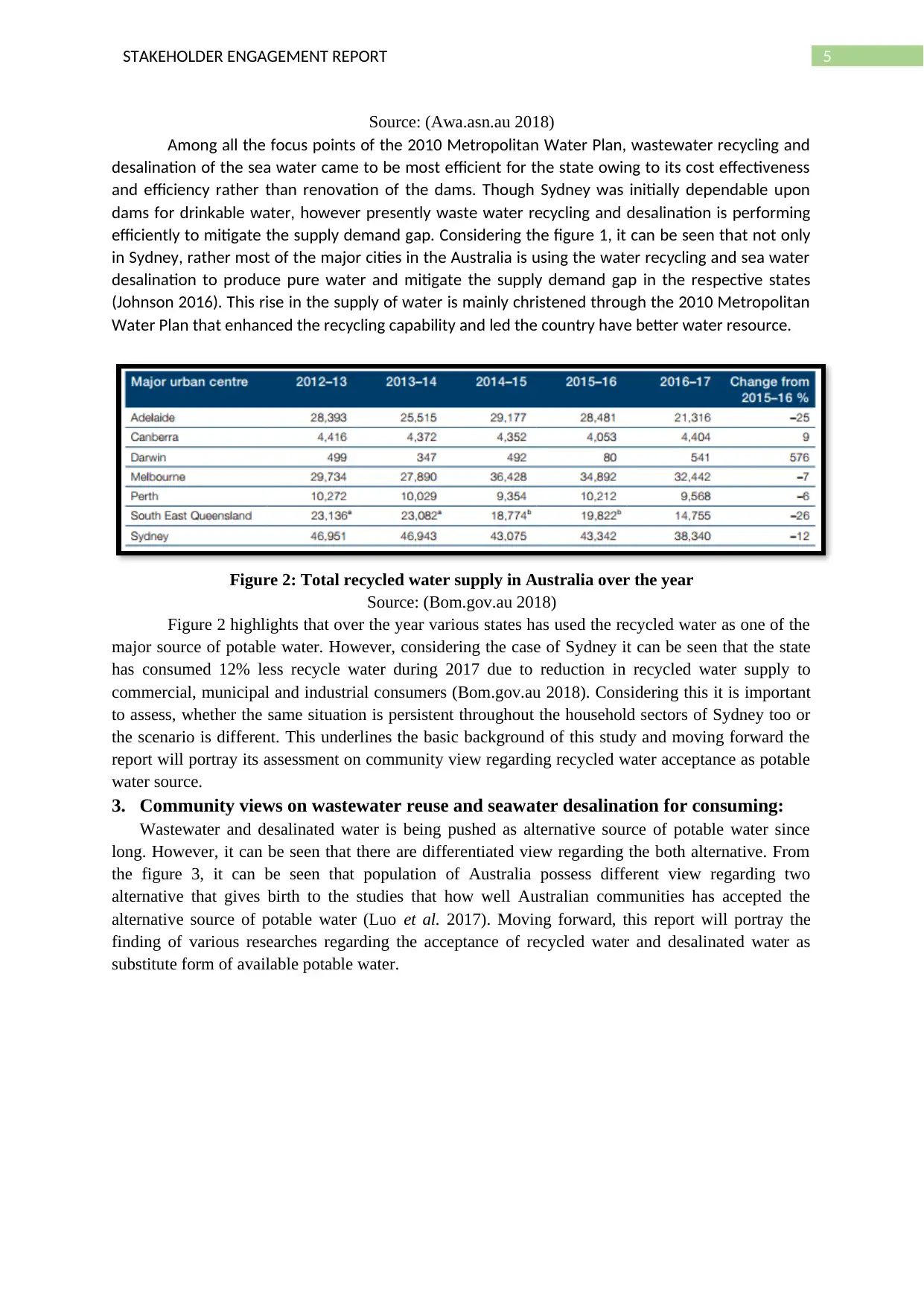
5STAKEHOLDER ENGAGEMENT REPORT
Source: (Awa.asn.au 2018)
Among all the focus points of the 2010 Metropolitan Water Plan, wastewater recycling and
desalination of the sea water came to be most efficient for the state owing to its cost effectiveness
and efficiency rather than renovation of the dams. Though Sydney was initially dependable upon
dams for drinkable water, however presently waste water recycling and desalination is performing
efficiently to mitigate the supply demand gap. Considering the figure 1, it can be seen that not only
in Sydney, rather most of the major cities in the Australia is using the water recycling and sea water
desalination to produce pure water and mitigate the supply demand gap in the respective states
(Johnson 2016). This rise in the supply of water is mainly christened through the 2010 Metropolitan
Water Plan that enhanced the recycling capability and led the country have better water resource.
Figure 2: Total recycled water supply in Australia over the year
Source: (Bom.gov.au 2018)
Figure 2 highlights that over the year various states has used the recycled water as one of the
major source of potable water. However, considering the case of Sydney it can be seen that the state
has consumed 12% less recycle water during 2017 due to reduction in recycled water supply to
commercial, municipal and industrial consumers (Bom.gov.au 2018). Considering this it is important
to assess, whether the same situation is persistent throughout the household sectors of Sydney too or
the scenario is different. This underlines the basic background of this study and moving forward the
report will portray its assessment on community view regarding recycled water acceptance as potable
water source.
3. Community views on wastewater reuse and seawater desalination for consuming:
Wastewater and desalinated water is being pushed as alternative source of potable water since
long. However, it can be seen that there are differentiated view regarding the both alternative. From
the figure 3, it can be seen that population of Australia possess different view regarding two
alternative that gives birth to the studies that how well Australian communities has accepted the
alternative source of potable water (Luo et al. 2017). Moving forward, this report will portray the
finding of various researches regarding the acceptance of recycled water and desalinated water as
substitute form of available potable water.
Source: (Awa.asn.au 2018)
Among all the focus points of the 2010 Metropolitan Water Plan, wastewater recycling and
desalination of the sea water came to be most efficient for the state owing to its cost effectiveness
and efficiency rather than renovation of the dams. Though Sydney was initially dependable upon
dams for drinkable water, however presently waste water recycling and desalination is performing
efficiently to mitigate the supply demand gap. Considering the figure 1, it can be seen that not only
in Sydney, rather most of the major cities in the Australia is using the water recycling and sea water
desalination to produce pure water and mitigate the supply demand gap in the respective states
(Johnson 2016). This rise in the supply of water is mainly christened through the 2010 Metropolitan
Water Plan that enhanced the recycling capability and led the country have better water resource.
Figure 2: Total recycled water supply in Australia over the year
Source: (Bom.gov.au 2018)
Figure 2 highlights that over the year various states has used the recycled water as one of the
major source of potable water. However, considering the case of Sydney it can be seen that the state
has consumed 12% less recycle water during 2017 due to reduction in recycled water supply to
commercial, municipal and industrial consumers (Bom.gov.au 2018). Considering this it is important
to assess, whether the same situation is persistent throughout the household sectors of Sydney too or
the scenario is different. This underlines the basic background of this study and moving forward the
report will portray its assessment on community view regarding recycled water acceptance as potable
water source.
3. Community views on wastewater reuse and seawater desalination for consuming:
Wastewater and desalinated water is being pushed as alternative source of potable water since
long. However, it can be seen that there are differentiated view regarding the both alternative. From
the figure 3, it can be seen that population of Australia possess different view regarding two
alternative that gives birth to the studies that how well Australian communities has accepted the
alternative source of potable water (Luo et al. 2017). Moving forward, this report will portray the
finding of various researches regarding the acceptance of recycled water and desalinated water as
substitute form of available potable water.
⊘ This is a preview!⊘
Do you want full access?
Subscribe today to unlock all pages.

Trusted by 1+ million students worldwide
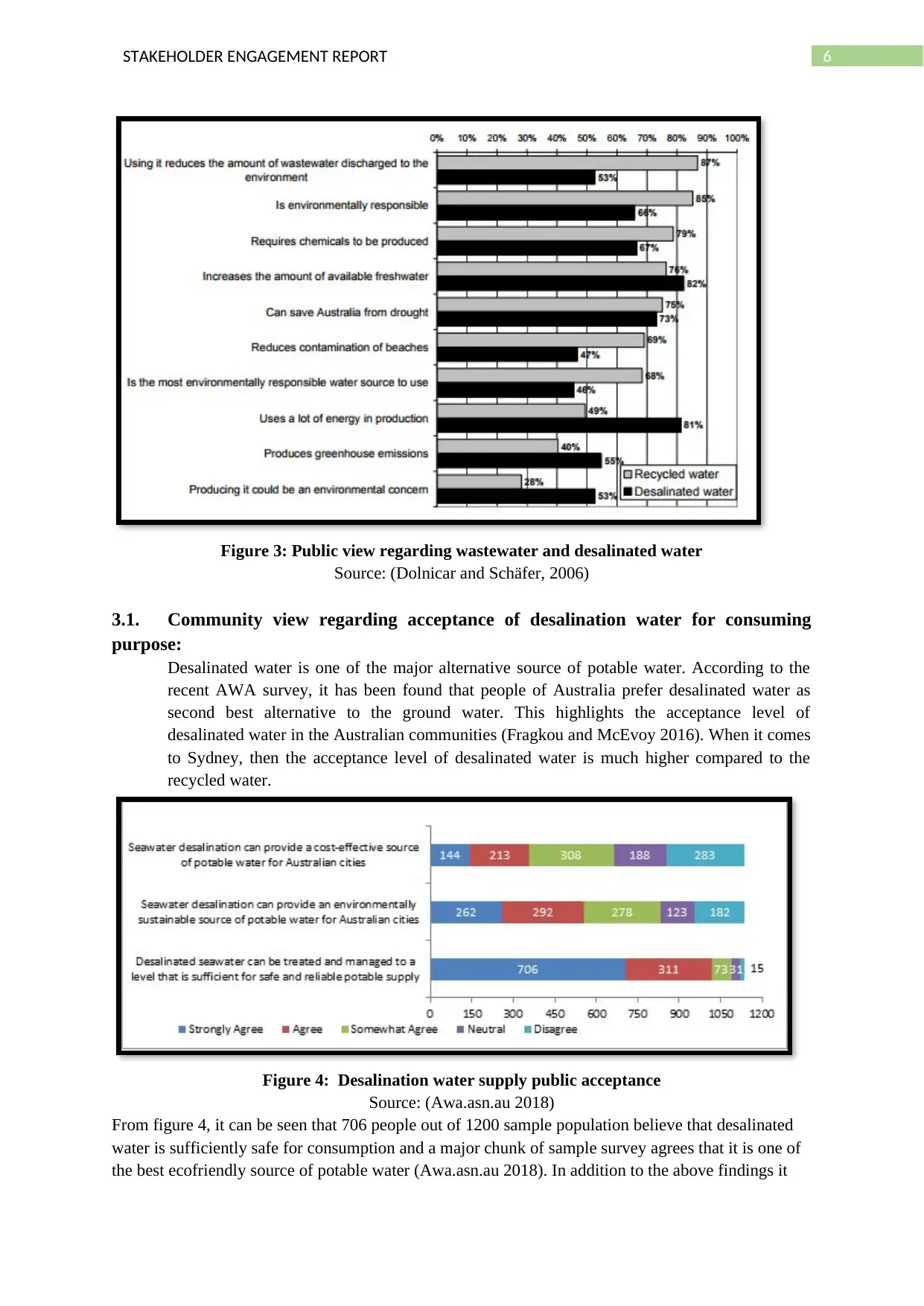
6STAKEHOLDER ENGAGEMENT REPORT
Figure 3: Public view regarding wastewater and desalinated water
Source: (Dolnicar and Schäfer, 2006)
3.1. Community view regarding acceptance of desalination water for consuming
purpose:
Desalinated water is one of the major alternative source of potable water. According to the
recent AWA survey, it has been found that people of Australia prefer desalinated water as
second best alternative to the ground water. This highlights the acceptance level of
desalinated water in the Australian communities (Fragkou and McEvoy 2016). When it comes
to Sydney, then the acceptance level of desalinated water is much higher compared to the
recycled water.
Figure 4: Desalination water supply public acceptance
Source: (Awa.asn.au 2018)
From figure 4, it can be seen that 706 people out of 1200 sample population believe that desalinated
water is sufficiently safe for consumption and a major chunk of sample survey agrees that it is one of
the best ecofriendly source of potable water (Awa.asn.au 2018). In addition to the above findings it
Figure 3: Public view regarding wastewater and desalinated water
Source: (Dolnicar and Schäfer, 2006)
3.1. Community view regarding acceptance of desalination water for consuming
purpose:
Desalinated water is one of the major alternative source of potable water. According to the
recent AWA survey, it has been found that people of Australia prefer desalinated water as
second best alternative to the ground water. This highlights the acceptance level of
desalinated water in the Australian communities (Fragkou and McEvoy 2016). When it comes
to Sydney, then the acceptance level of desalinated water is much higher compared to the
recycled water.
Figure 4: Desalination water supply public acceptance
Source: (Awa.asn.au 2018)
From figure 4, it can be seen that 706 people out of 1200 sample population believe that desalinated
water is sufficiently safe for consumption and a major chunk of sample survey agrees that it is one of
the best ecofriendly source of potable water (Awa.asn.au 2018). In addition to the above findings it
Paraphrase This Document
Need a fresh take? Get an instant paraphrase of this document with our AI Paraphraser
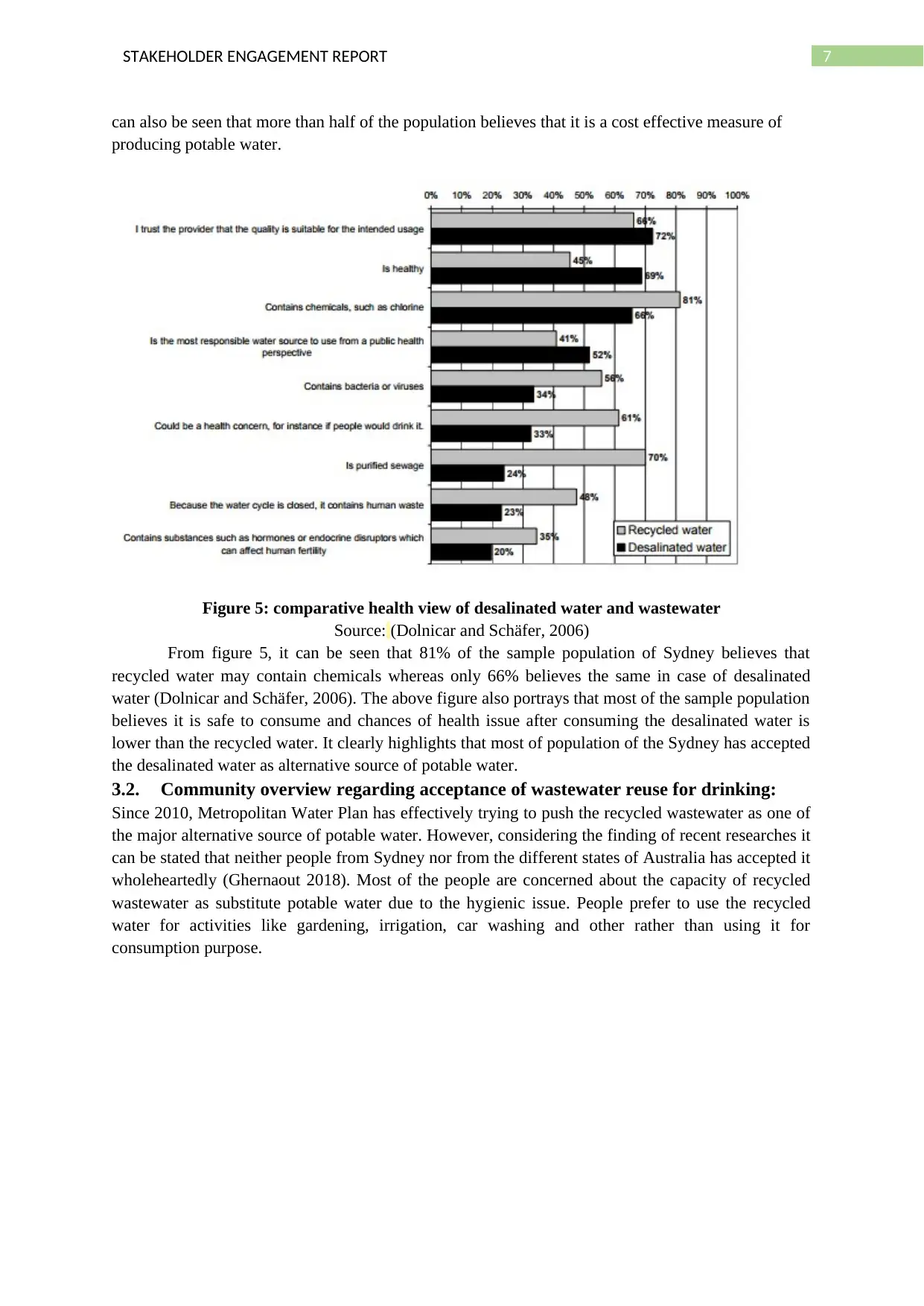
7STAKEHOLDER ENGAGEMENT REPORT
can also be seen that more than half of the population believes that it is a cost effective measure of
producing potable water.
Figure 5: comparative health view of desalinated water and wastewater
Source: (Dolnicar and Schäfer, 2006)
From figure 5, it can be seen that 81% of the sample population of Sydney believes that
recycled water may contain chemicals whereas only 66% believes the same in case of desalinated
water (Dolnicar and Schäfer, 2006). The above figure also portrays that most of the sample population
believes it is safe to consume and chances of health issue after consuming the desalinated water is
lower than the recycled water. It clearly highlights that most of population of the Sydney has accepted
the desalinated water as alternative source of potable water.
3.2. Community overview regarding acceptance of wastewater reuse for drinking:
Since 2010, Metropolitan Water Plan has effectively trying to push the recycled wastewater as one of
the major alternative source of potable water. However, considering the finding of recent researches it
can be stated that neither people from Sydney nor from the different states of Australia has accepted it
wholeheartedly (Ghernaout 2018). Most of the people are concerned about the capacity of recycled
wastewater as substitute potable water due to the hygienic issue. People prefer to use the recycled
water for activities like gardening, irrigation, car washing and other rather than using it for
consumption purpose.
can also be seen that more than half of the population believes that it is a cost effective measure of
producing potable water.
Figure 5: comparative health view of desalinated water and wastewater
Source: (Dolnicar and Schäfer, 2006)
From figure 5, it can be seen that 81% of the sample population of Sydney believes that
recycled water may contain chemicals whereas only 66% believes the same in case of desalinated
water (Dolnicar and Schäfer, 2006). The above figure also portrays that most of the sample population
believes it is safe to consume and chances of health issue after consuming the desalinated water is
lower than the recycled water. It clearly highlights that most of population of the Sydney has accepted
the desalinated water as alternative source of potable water.
3.2. Community overview regarding acceptance of wastewater reuse for drinking:
Since 2010, Metropolitan Water Plan has effectively trying to push the recycled wastewater as one of
the major alternative source of potable water. However, considering the finding of recent researches it
can be stated that neither people from Sydney nor from the different states of Australia has accepted it
wholeheartedly (Ghernaout 2018). Most of the people are concerned about the capacity of recycled
wastewater as substitute potable water due to the hygienic issue. People prefer to use the recycled
water for activities like gardening, irrigation, car washing and other rather than using it for
consumption purpose.
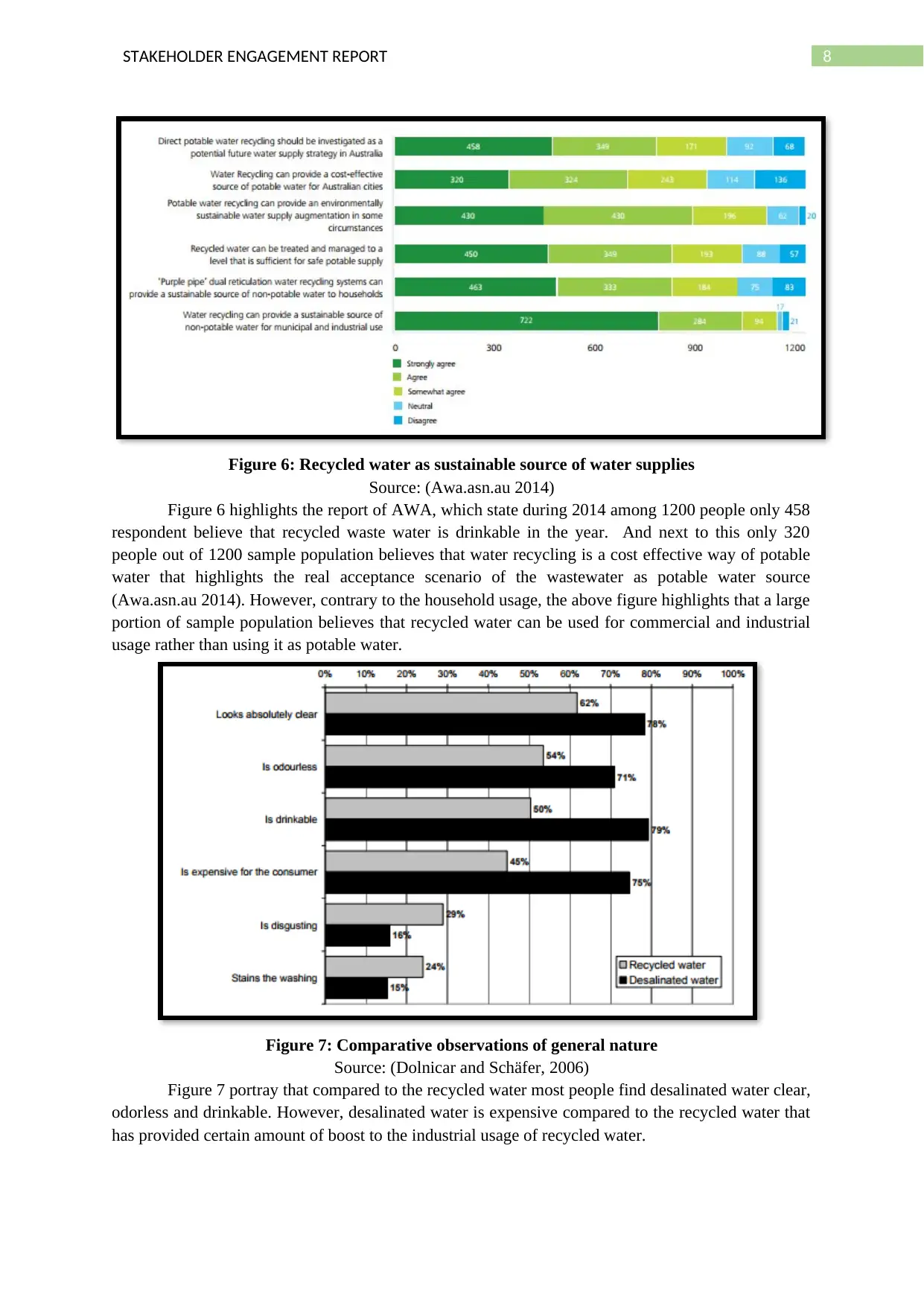
8STAKEHOLDER ENGAGEMENT REPORT
Figure 6: Recycled water as sustainable source of water supplies
Source: (Awa.asn.au 2014)
Figure 6 highlights the report of AWA, which state during 2014 among 1200 people only 458
respondent believe that recycled waste water is drinkable in the year. And next to this only 320
people out of 1200 sample population believes that water recycling is a cost effective way of potable
water that highlights the real acceptance scenario of the wastewater as potable water source
(Awa.asn.au 2014). However, contrary to the household usage, the above figure highlights that a large
portion of sample population believes that recycled water can be used for commercial and industrial
usage rather than using it as potable water.
Figure 7: Comparative observations of general nature
Source: (Dolnicar and Schäfer, 2006)
Figure 7 portray that compared to the recycled water most people find desalinated water clear,
odorless and drinkable. However, desalinated water is expensive compared to the recycled water that
has provided certain amount of boost to the industrial usage of recycled water.
Figure 6: Recycled water as sustainable source of water supplies
Source: (Awa.asn.au 2014)
Figure 6 highlights the report of AWA, which state during 2014 among 1200 people only 458
respondent believe that recycled waste water is drinkable in the year. And next to this only 320
people out of 1200 sample population believes that water recycling is a cost effective way of potable
water that highlights the real acceptance scenario of the wastewater as potable water source
(Awa.asn.au 2014). However, contrary to the household usage, the above figure highlights that a large
portion of sample population believes that recycled water can be used for commercial and industrial
usage rather than using it as potable water.
Figure 7: Comparative observations of general nature
Source: (Dolnicar and Schäfer, 2006)
Figure 7 portray that compared to the recycled water most people find desalinated water clear,
odorless and drinkable. However, desalinated water is expensive compared to the recycled water that
has provided certain amount of boost to the industrial usage of recycled water.
⊘ This is a preview!⊘
Do you want full access?
Subscribe today to unlock all pages.

Trusted by 1+ million students worldwide
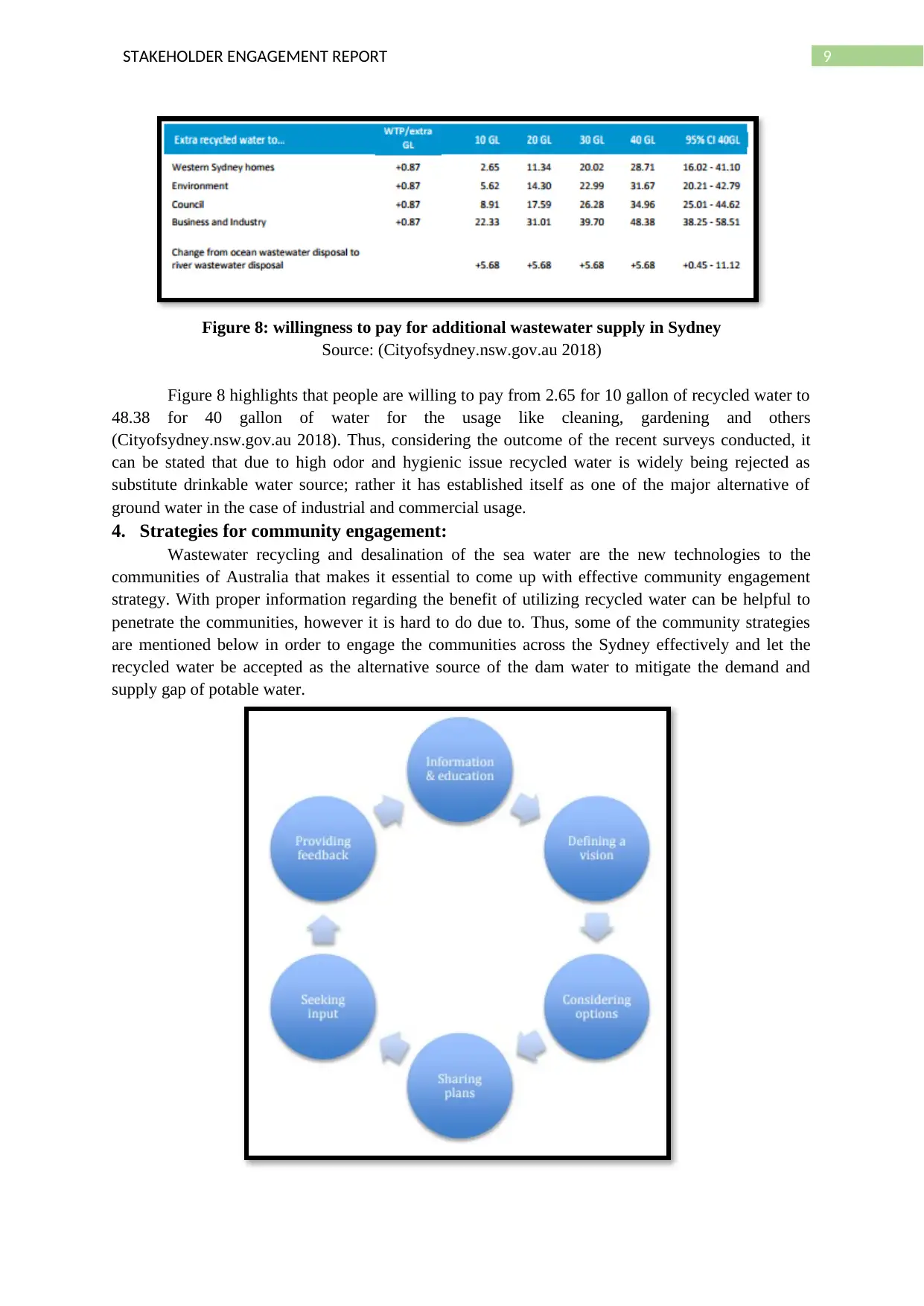
9STAKEHOLDER ENGAGEMENT REPORT
Figure 8: willingness to pay for additional wastewater supply in Sydney
Source: (Cityofsydney.nsw.gov.au 2018)
Figure 8 highlights that people are willing to pay from 2.65 for 10 gallon of recycled water to
48.38 for 40 gallon of water for the usage like cleaning, gardening and others
(Cityofsydney.nsw.gov.au 2018). Thus, considering the outcome of the recent surveys conducted, it
can be stated that due to high odor and hygienic issue recycled water is widely being rejected as
substitute drinkable water source; rather it has established itself as one of the major alternative of
ground water in the case of industrial and commercial usage.
4. Strategies for community engagement:
Wastewater recycling and desalination of the sea water are the new technologies to the
communities of Australia that makes it essential to come up with effective community engagement
strategy. With proper information regarding the benefit of utilizing recycled water can be helpful to
penetrate the communities, however it is hard to do due to. Thus, some of the community strategies
are mentioned below in order to engage the communities across the Sydney effectively and let the
recycled water be accepted as the alternative source of the dam water to mitigate the demand and
supply gap of potable water.
Figure 8: willingness to pay for additional wastewater supply in Sydney
Source: (Cityofsydney.nsw.gov.au 2018)
Figure 8 highlights that people are willing to pay from 2.65 for 10 gallon of recycled water to
48.38 for 40 gallon of water for the usage like cleaning, gardening and others
(Cityofsydney.nsw.gov.au 2018). Thus, considering the outcome of the recent surveys conducted, it
can be stated that due to high odor and hygienic issue recycled water is widely being rejected as
substitute drinkable water source; rather it has established itself as one of the major alternative of
ground water in the case of industrial and commercial usage.
4. Strategies for community engagement:
Wastewater recycling and desalination of the sea water are the new technologies to the
communities of Australia that makes it essential to come up with effective community engagement
strategy. With proper information regarding the benefit of utilizing recycled water can be helpful to
penetrate the communities, however it is hard to do due to. Thus, some of the community strategies
are mentioned below in order to engage the communities across the Sydney effectively and let the
recycled water be accepted as the alternative source of the dam water to mitigate the demand and
supply gap of potable water.
Paraphrase This Document
Need a fresh take? Get an instant paraphrase of this document with our AI Paraphraser
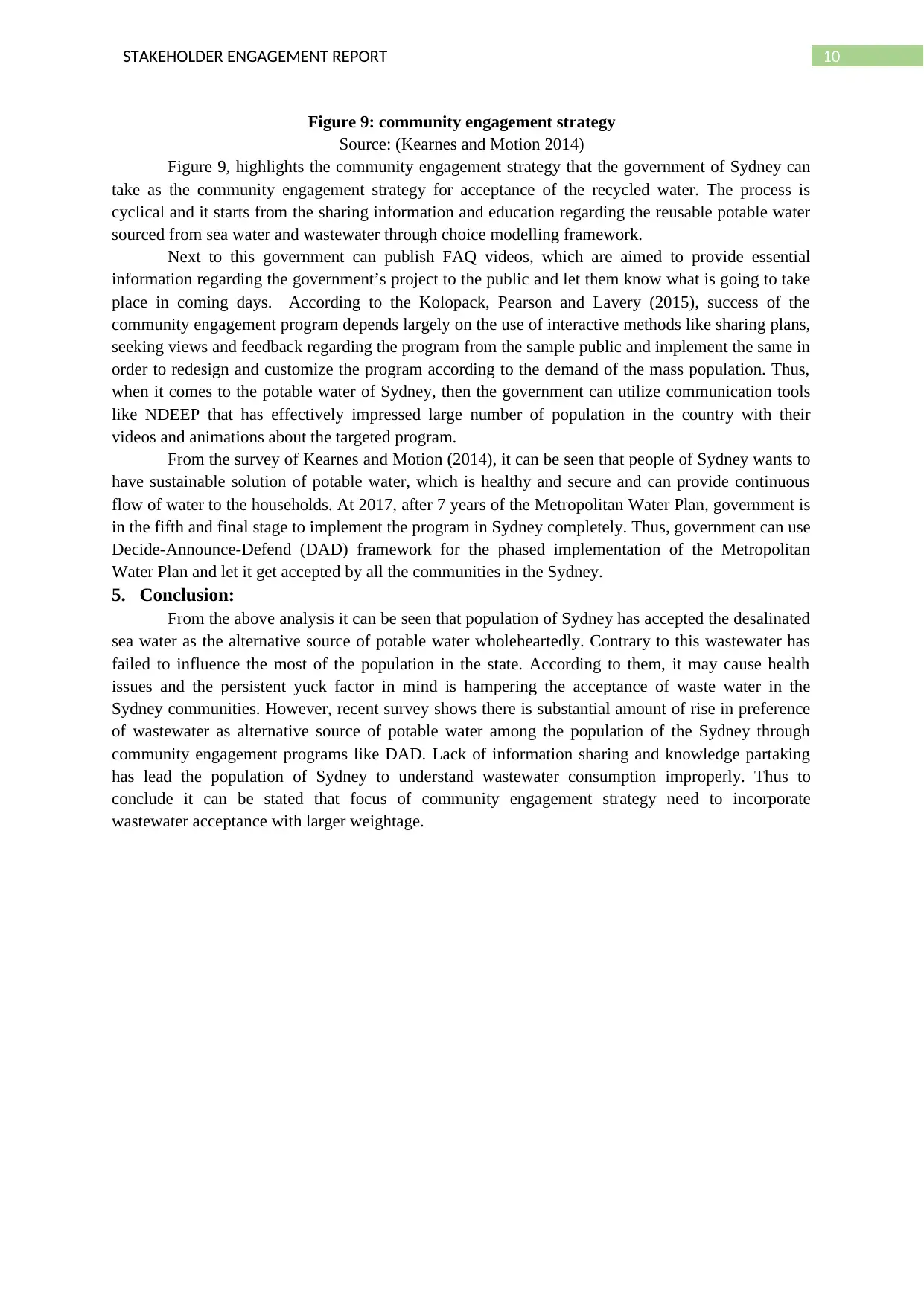
10STAKEHOLDER ENGAGEMENT REPORT
Figure 9: community engagement strategy
Source: (Kearnes and Motion 2014)
Figure 9, highlights the community engagement strategy that the government of Sydney can
take as the community engagement strategy for acceptance of the recycled water. The process is
cyclical and it starts from the sharing information and education regarding the reusable potable water
sourced from sea water and wastewater through choice modelling framework.
Next to this government can publish FAQ videos, which are aimed to provide essential
information regarding the government’s project to the public and let them know what is going to take
place in coming days. According to the Kolopack, Pearson and Lavery (2015), success of the
community engagement program depends largely on the use of interactive methods like sharing plans,
seeking views and feedback regarding the program from the sample public and implement the same in
order to redesign and customize the program according to the demand of the mass population. Thus,
when it comes to the potable water of Sydney, then the government can utilize communication tools
like NDEEP that has effectively impressed large number of population in the country with their
videos and animations about the targeted program.
From the survey of Kearnes and Motion (2014), it can be seen that people of Sydney wants to
have sustainable solution of potable water, which is healthy and secure and can provide continuous
flow of water to the households. At 2017, after 7 years of the Metropolitan Water Plan, government is
in the fifth and final stage to implement the program in Sydney completely. Thus, government can use
Decide-Announce-Defend (DAD) framework for the phased implementation of the Metropolitan
Water Plan and let it get accepted by all the communities in the Sydney.
5. Conclusion:
From the above analysis it can be seen that population of Sydney has accepted the desalinated
sea water as the alternative source of potable water wholeheartedly. Contrary to this wastewater has
failed to influence the most of the population in the state. According to them, it may cause health
issues and the persistent yuck factor in mind is hampering the acceptance of waste water in the
Sydney communities. However, recent survey shows there is substantial amount of rise in preference
of wastewater as alternative source of potable water among the population of the Sydney through
community engagement programs like DAD. Lack of information sharing and knowledge partaking
has lead the population of Sydney to understand wastewater consumption improperly. Thus to
conclude it can be stated that focus of community engagement strategy need to incorporate
wastewater acceptance with larger weightage.
Figure 9: community engagement strategy
Source: (Kearnes and Motion 2014)
Figure 9, highlights the community engagement strategy that the government of Sydney can
take as the community engagement strategy for acceptance of the recycled water. The process is
cyclical and it starts from the sharing information and education regarding the reusable potable water
sourced from sea water and wastewater through choice modelling framework.
Next to this government can publish FAQ videos, which are aimed to provide essential
information regarding the government’s project to the public and let them know what is going to take
place in coming days. According to the Kolopack, Pearson and Lavery (2015), success of the
community engagement program depends largely on the use of interactive methods like sharing plans,
seeking views and feedback regarding the program from the sample public and implement the same in
order to redesign and customize the program according to the demand of the mass population. Thus,
when it comes to the potable water of Sydney, then the government can utilize communication tools
like NDEEP that has effectively impressed large number of population in the country with their
videos and animations about the targeted program.
From the survey of Kearnes and Motion (2014), it can be seen that people of Sydney wants to
have sustainable solution of potable water, which is healthy and secure and can provide continuous
flow of water to the households. At 2017, after 7 years of the Metropolitan Water Plan, government is
in the fifth and final stage to implement the program in Sydney completely. Thus, government can use
Decide-Announce-Defend (DAD) framework for the phased implementation of the Metropolitan
Water Plan and let it get accepted by all the communities in the Sydney.
5. Conclusion:
From the above analysis it can be seen that population of Sydney has accepted the desalinated
sea water as the alternative source of potable water wholeheartedly. Contrary to this wastewater has
failed to influence the most of the population in the state. According to them, it may cause health
issues and the persistent yuck factor in mind is hampering the acceptance of waste water in the
Sydney communities. However, recent survey shows there is substantial amount of rise in preference
of wastewater as alternative source of potable water among the population of the Sydney through
community engagement programs like DAD. Lack of information sharing and knowledge partaking
has lead the population of Sydney to understand wastewater consumption improperly. Thus to
conclude it can be stated that focus of community engagement strategy need to incorporate
wastewater acceptance with larger weightage.
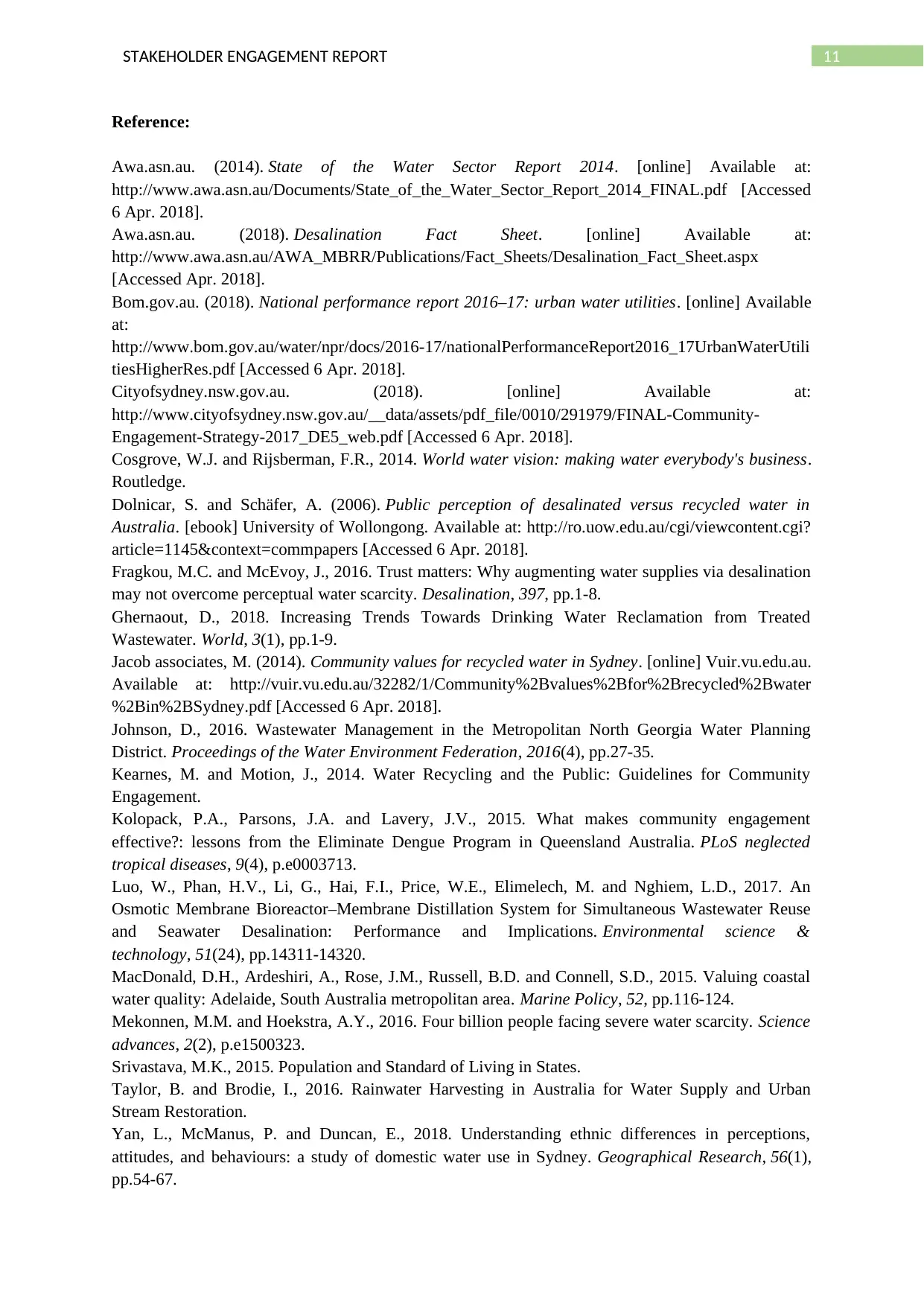
11STAKEHOLDER ENGAGEMENT REPORT
Reference:
Awa.asn.au. (2014). State of the Water Sector Report 2014. [online] Available at:
http://www.awa.asn.au/Documents/State_of_the_Water_Sector_Report_2014_FINAL.pdf [Accessed
6 Apr. 2018].
Awa.asn.au. (2018). Desalination Fact Sheet. [online] Available at:
http://www.awa.asn.au/AWA_MBRR/Publications/Fact_Sheets/Desalination_Fact_Sheet.aspx
[Accessed Apr. 2018].
Bom.gov.au. (2018). National performance report 2016–17: urban water utilities. [online] Available
at:
http://www.bom.gov.au/water/npr/docs/2016-17/nationalPerformanceReport2016_17UrbanWaterUtili
tiesHigherRes.pdf [Accessed 6 Apr. 2018].
Cityofsydney.nsw.gov.au. (2018). [online] Available at:
http://www.cityofsydney.nsw.gov.au/__data/assets/pdf_file/0010/291979/FINAL-Community-
Engagement-Strategy-2017_DE5_web.pdf [Accessed 6 Apr. 2018].
Cosgrove, W.J. and Rijsberman, F.R., 2014. World water vision: making water everybody's business.
Routledge.
Dolnicar, S. and Schäfer, A. (2006). Public perception of desalinated versus recycled water in
Australia. [ebook] University of Wollongong. Available at: http://ro.uow.edu.au/cgi/viewcontent.cgi?
article=1145&context=commpapers [Accessed 6 Apr. 2018].
Fragkou, M.C. and McEvoy, J., 2016. Trust matters: Why augmenting water supplies via desalination
may not overcome perceptual water scarcity. Desalination, 397, pp.1-8.
Ghernaout, D., 2018. Increasing Trends Towards Drinking Water Reclamation from Treated
Wastewater. World, 3(1), pp.1-9.
Jacob associates, M. (2014). Community values for recycled water in Sydney. [online] Vuir.vu.edu.au.
Available at: http://vuir.vu.edu.au/32282/1/Community%2Bvalues%2Bfor%2Brecycled%2Bwater
%2Bin%2BSydney.pdf [Accessed 6 Apr. 2018].
Johnson, D., 2016. Wastewater Management in the Metropolitan North Georgia Water Planning
District. Proceedings of the Water Environment Federation, 2016(4), pp.27-35.
Kearnes, M. and Motion, J., 2014. Water Recycling and the Public: Guidelines for Community
Engagement.
Kolopack, P.A., Parsons, J.A. and Lavery, J.V., 2015. What makes community engagement
effective?: lessons from the Eliminate Dengue Program in Queensland Australia. PLoS neglected
tropical diseases, 9(4), p.e0003713.
Luo, W., Phan, H.V., Li, G., Hai, F.I., Price, W.E., Elimelech, M. and Nghiem, L.D., 2017. An
Osmotic Membrane Bioreactor–Membrane Distillation System for Simultaneous Wastewater Reuse
and Seawater Desalination: Performance and Implications. Environmental science &
technology, 51(24), pp.14311-14320.
MacDonald, D.H., Ardeshiri, A., Rose, J.M., Russell, B.D. and Connell, S.D., 2015. Valuing coastal
water quality: Adelaide, South Australia metropolitan area. Marine Policy, 52, pp.116-124.
Mekonnen, M.M. and Hoekstra, A.Y., 2016. Four billion people facing severe water scarcity. Science
advances, 2(2), p.e1500323.
Srivastava, M.K., 2015. Population and Standard of Living in States.
Taylor, B. and Brodie, I., 2016. Rainwater Harvesting in Australia for Water Supply and Urban
Stream Restoration.
Yan, L., McManus, P. and Duncan, E., 2018. Understanding ethnic differences in perceptions,
attitudes, and behaviours: a study of domestic water use in Sydney. Geographical Research, 56(1),
pp.54-67.
Reference:
Awa.asn.au. (2014). State of the Water Sector Report 2014. [online] Available at:
http://www.awa.asn.au/Documents/State_of_the_Water_Sector_Report_2014_FINAL.pdf [Accessed
6 Apr. 2018].
Awa.asn.au. (2018). Desalination Fact Sheet. [online] Available at:
http://www.awa.asn.au/AWA_MBRR/Publications/Fact_Sheets/Desalination_Fact_Sheet.aspx
[Accessed Apr. 2018].
Bom.gov.au. (2018). National performance report 2016–17: urban water utilities. [online] Available
at:
http://www.bom.gov.au/water/npr/docs/2016-17/nationalPerformanceReport2016_17UrbanWaterUtili
tiesHigherRes.pdf [Accessed 6 Apr. 2018].
Cityofsydney.nsw.gov.au. (2018). [online] Available at:
http://www.cityofsydney.nsw.gov.au/__data/assets/pdf_file/0010/291979/FINAL-Community-
Engagement-Strategy-2017_DE5_web.pdf [Accessed 6 Apr. 2018].
Cosgrove, W.J. and Rijsberman, F.R., 2014. World water vision: making water everybody's business.
Routledge.
Dolnicar, S. and Schäfer, A. (2006). Public perception of desalinated versus recycled water in
Australia. [ebook] University of Wollongong. Available at: http://ro.uow.edu.au/cgi/viewcontent.cgi?
article=1145&context=commpapers [Accessed 6 Apr. 2018].
Fragkou, M.C. and McEvoy, J., 2016. Trust matters: Why augmenting water supplies via desalination
may not overcome perceptual water scarcity. Desalination, 397, pp.1-8.
Ghernaout, D., 2018. Increasing Trends Towards Drinking Water Reclamation from Treated
Wastewater. World, 3(1), pp.1-9.
Jacob associates, M. (2014). Community values for recycled water in Sydney. [online] Vuir.vu.edu.au.
Available at: http://vuir.vu.edu.au/32282/1/Community%2Bvalues%2Bfor%2Brecycled%2Bwater
%2Bin%2BSydney.pdf [Accessed 6 Apr. 2018].
Johnson, D., 2016. Wastewater Management in the Metropolitan North Georgia Water Planning
District. Proceedings of the Water Environment Federation, 2016(4), pp.27-35.
Kearnes, M. and Motion, J., 2014. Water Recycling and the Public: Guidelines for Community
Engagement.
Kolopack, P.A., Parsons, J.A. and Lavery, J.V., 2015. What makes community engagement
effective?: lessons from the Eliminate Dengue Program in Queensland Australia. PLoS neglected
tropical diseases, 9(4), p.e0003713.
Luo, W., Phan, H.V., Li, G., Hai, F.I., Price, W.E., Elimelech, M. and Nghiem, L.D., 2017. An
Osmotic Membrane Bioreactor–Membrane Distillation System for Simultaneous Wastewater Reuse
and Seawater Desalination: Performance and Implications. Environmental science &
technology, 51(24), pp.14311-14320.
MacDonald, D.H., Ardeshiri, A., Rose, J.M., Russell, B.D. and Connell, S.D., 2015. Valuing coastal
water quality: Adelaide, South Australia metropolitan area. Marine Policy, 52, pp.116-124.
Mekonnen, M.M. and Hoekstra, A.Y., 2016. Four billion people facing severe water scarcity. Science
advances, 2(2), p.e1500323.
Srivastava, M.K., 2015. Population and Standard of Living in States.
Taylor, B. and Brodie, I., 2016. Rainwater Harvesting in Australia for Water Supply and Urban
Stream Restoration.
Yan, L., McManus, P. and Duncan, E., 2018. Understanding ethnic differences in perceptions,
attitudes, and behaviours: a study of domestic water use in Sydney. Geographical Research, 56(1),
pp.54-67.
⊘ This is a preview!⊘
Do you want full access?
Subscribe today to unlock all pages.

Trusted by 1+ million students worldwide
1 out of 13
Your All-in-One AI-Powered Toolkit for Academic Success.
+13062052269
info@desklib.com
Available 24*7 on WhatsApp / Email
![[object Object]](/_next/static/media/star-bottom.7253800d.svg)
Unlock your academic potential
Copyright © 2020–2025 A2Z Services. All Rights Reserved. Developed and managed by ZUCOL.


